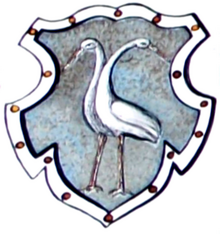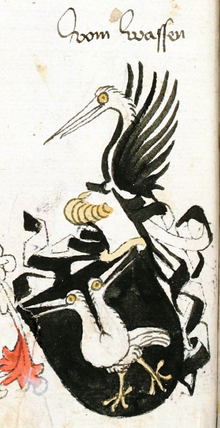Wasen (noble family)
The lords of Wasen were a knightly noble family who were wealthy in Maingau and in the vicinity of the city of Aschaffenburg .
history
Ancestral seat of the family, which has been tangible since the 12th century, is probably an abandoned castle on the western slope of the Steiger mountain near Unterbessenbach . A member of the family first met as a witness for a document on March 4, 1150. His place in the order of the list of witnesses suggests that he was a nobleman .
The rise of the sex is closely linked to the Electoral Mainz city of Aschaffenburg and the collegiate monastery of St. Peter and Alexander there . Konrad von Wasen is 1268 likely alderman of the city. When the citizens revolted against the monastery in 1304, the knight Friedrich von Wasen was one of the two arbitrators nominated by the city. From 1311 to 1332 Mechtild von Wasen was abbess at Schmerlenbach Abbey . Friedrich von Wasen is attested as a canon judge in 1350. In 1374 Conrad von Wasen, poorer , can be proven to be the town magistrate. 1461–1465 there is evidence of a legal dispute with the monastery about tithe rights and basic interest on the goods on Godelsberg, Pfaffenberg, Beyersberg, Rosenberg, Ziegelberg and on Strudelbach. In Frankfurt am Main , Winter von Wasen was the city's mayor in 1388 . In this capacity he was captured during the Kronberg feud .
In the late Middle Ages, the family split into two lines, Aschaffenburg and Babenhausen . The Aschaffenburg line became extinct around the middle of the 16th century. The Babenhausen line ends in 1611 with Hans von Wasen, bailiff of Grünsfeld and his later son Johann Wolfgang († 1612).
possession
Aschaffenburg
The Lords of Wasen in Aschaffenburg had owned the Großer Riese am Herstall house since the 13th century . In a will from Nicolaus von Wasen from 1344, two neighboring houses and two more new houses had already been added. In 1421, Henne von Wasen owned a castle loan from the Mainz archbishopric in Aschaffenburg. In the 14th century one meets name bearers as members of the monastery and in its monastery necrologist. Sales of the Aschaffenburg property are documented in the 16th century. In 1502, Eberhard von Wasen and his wife sold the large and small tithe in and around Aschaffenburg to the monastery for 650 florins. In 1530, the guardians of his heirs sold further tithe rights to the monastery.
Lower Main Area
Outside of Aschaffenburg, the Lords of Wasen often appeared as Mainz forest servants and feudal men of the following territorial lords:
- Archdiocese of Mainz
- Aschaffenburg pen sprinkler
- Lordship of Bickenbach
- County of Hanau-Munzenberg
- County of Hanau-Lichtenberg
- Isenburg County
- County of Erbach
- County of Rieneck
- Counts of Wertheim
- Free Imperial City of Frankfurt am Main
- Burgraviate of Friedberg
1403 enfeoffed a Konrad IX. von Bickenbach , Burgrave of Miltenberg , Philipp von Wasen with the wine and grain tithe to Wenigumstadt, which can be leased from the Bickenbach rulership . In the Klingenberg feud (before 1437) between the Archbishop of Mainz Theoderich von Erbach and the Burgmannen of the Bickenbacher Clingenburg , a Friedrich von dem Wasen is named in the arbitration award of 1439 . In 1451 Winter von Wasen has a special court in Bieber from Gottfried von Eppstein . A lending to the Haus Schloss by the Counts of Hanau has been documented since at least 1452 . In 1464 they were enfeoffed by the Bickenbachers with the ninth part of the tithe in Mömlingen .
In 1479 the Lorsch Gospels were newly bound under the Premonstratensian provost Eberhard von Wasen (Eberhard II after counting the Lorsch Monastery ) . His coat of arms is embossed on the cover.
The von Wasen are called Burgmannen von Babenhausen (1480–1592) and had many fiefs in the Bachgau area up to the city of Dieburg and Eppertshausen (in whose later coat of arms they were included due to extensive possessions). They were often associated with the local nobility, such as a Cons von Wasen , who married Jutta Wambolt von Umstadt in the mid-14th century . Anna von Wasen was married to Volprecht Riedesel von Eisenbach at the beginning of the 14th century . Heinrich von Wasen , probably the brother of Hans von Wasen , was married to Gertraud von Berlichingen . His daughter, Katharina Christophera, and his wife Hans von Wasens, née Wolfskeel , fought over the inheritance of von Wasen, who died out in the male line.
coat of arms

The coat of arms of the Lords of Wasen is a "secret talking " one. It shows a wader ( stork or crane ). The coat of arms is documented in variants of numerous aristocratic families in the region ( von Bessenbach , von Kugelberg von Weiler , von Heidebach and von Wallstadt ). With some probability it can be assumed that these families took over the coat of arms through parentage or marriage, whereby the oldest and original form can be assumed for the lords of Wasen due to the connection to the name.
On each of the oldest seals a single-headed wader can be seen in a black field. The background of the shield is sprinkled with changing symbols: small stars, spheres, crosses, and in the latest forms, clovers. The Aschaffenburg line changes from 1344 with Friedrich and Nicolaus von Wasen to a double-headed stork. The colors remain the same, there are no markings at first, later the black field is sprinkled with gold crosses. The Babenhausen line retained the single-headed stork on a black field until it became extinct.
Both lines initially use a stork's trunk as a crest, later it becomes a growing stork with raised wings, and finally a standing stork between two black wings.
Coat of arms of the municipality of Eppertshausen : clovers and storks are assigned to von Wasen, blue shield and inclined beams are assigned to Groschlag von Dieburg Double-headed stork in the coat of arms of Glattbach , where the Lords of Wasen owned an estate from 1387 to 1528. Coat of arms of Bessenbach with the double-headed stork of the Lords of Bessenbach .
literature
- Heinrich Bingemer: The Frankfurt coat of arms booklet. 2nd edition, Kramer, Frankfurt 1987, ISBN 3-7829-0348-X , p. 39 plate 33.
- Roman Fischer: Aschaffenburg in the Middle Ages. Studies of the history of the city from the beginnings to the beginning of the modern era. Aschaffenburg 1989, ISBN 3-87965-041-1 ( publications of the Aschaffenburg History and Art Association 32 ), pp. 230–232.
- Alfred F. Wolfert: Groups of coats of arms of the nobility in the Odenwald-Spessart area. In: Winfried Wackerfuß (Ed.): Contributions to the exploration of the Odenwald and its peripheral landscapes II. Festschrift for Hans H. Weber. Breuberg-Bund , Breuberg-Neustadt 1977, pp. 325-406, here pp. 351f.
- Josef Kittel, Peter Fleck: The gentlemen from Wasen to Aschaffenburg and Babenhausen : Described from collected documents; with attached family tree , 1894
Individual evidence
- ^ R. Fischer: Aschaffenburg in the Middle Ages. Aschaffenburg 1989, p. 230.
- ↑ Peter Acht: Mainzer Urkundenbuch: The documents from the death of Archbishop Adalbert I (1137) to the death of Archbishop Konrad (1200) Volume 2.1. 1137 - 1175. Publishing house of the Historisches Verein für Hessen, Darmstadt 1968, No. 191.
- ^ R. Fischer: Aschaffenburg in the Middle Ages. Aschaffenburg 1989, p. 231f.
- ^ R. Fischer: Aschaffenburg in the Middle Ages. Aschaffenburg 1989, p. 231.
- ↑ Dieter Michael Feineis: The Bickenbachers and the Hohenberg rule in: Würzburger Diözesan Geschichtsblätter (PDF file; 2.1 MB) 64th volume, special edition, Diocese of Würzburg 2002.
- ↑ Hessisches Staatsarchiv Darmstadt : HStAD inventory F 16: No. 209, No. 236/1, No. 864, No. 874, No. 799; HStAD inventory B 20: No. 589; HStAD inventory D 21 A: No. 60/7.
- ^ Gerhard Rechter: Die Seckendorff: The lines Nold, Egersdorf, Hoheneck and Pfaff , Schöningh 1990, Verlag Degener, pp. 93-99.
- ↑ Karl Pohl: The end of the Carolingian monastery Rotaha , specialist publication, Vlg.GRIN, 2008, ISBN 978-3-640-21178-4 , p. 46
- ^ Alfred F. Wolfert: Groups of coats of arms of the nobility in the Odenwald-Spessart area. In: Winfried Wackerfuß (Ed.): Contributions to the exploration of the Odenwald and its peripheral landscapes II. Festschrift for Hans H. Weber. Breuberg-Bund , Breuberg-Neustadt 1977, pp. 325–406, here p. 351.
- ↑ cf. City of Eppertshausen - coat of arms history ( page no longer available , search in web archives ) Info: The link was automatically marked as defective. Please check the link according to the instructions and then remove this notice. (PDF file; 90 kB)




